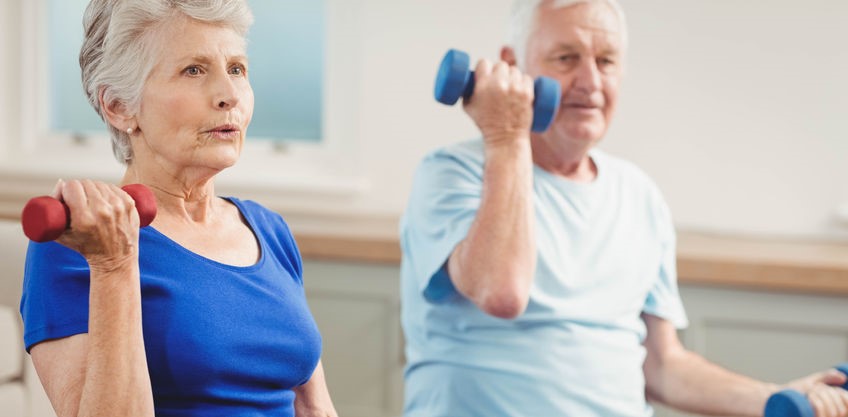Aegis Therapies offers some guidelines to help make sure caregivers are tuned in to potentially life threatening symptoms of overexertion.
By Susan Saldibar
So it’s exercise time at your local senior living community. Everyone’s having a good time “sweatin’ to the oldies”. Up on the flat panel is Richard Simmons pumping along to some of the standards of the 50s and 60s. Everyone is into it, counting “one, two, three” and then — boom — something happens. Someone faints, or vomits, or, worse yet, grabs his or her chest.
Were there warning signs? Sure there were. But no one saw or heard them. They weren’t paying attention. But they are now. Because now the senior living operator may have a hospital re-admission on their hands. Or something much worse.
Abnormal Reaction To Exercise
Susan Almon-Matangos, Speech-Language Pathologist and National Clinical Director for Aegis Therapies (a Senior Housing Forum partner), says the risk for abnormal reactions to exercise is very real. In an industry focused on monitoring so many medical and functional aspects of its residents, there is also a need to assure that serious symptoms during exercise time do not fall through the cracks unnoticed.
Here is a digested version of the chart Aegis Therapies uses to make sure caregivers are tuned in to potentially life threatening symptoms of over-exertion.
|
Symptom |
Possible Cause |
Remedy |
|
Abnormal heart action • Pulse becomes irregular (skipping beats). • Fluttering, jumping, or palpitations in chest or throat. • Sudden very slow pulse if initially on target. (immediate or delayed) • Sudden burst of rapid heartbeats. |
Extra heart beats, dropped heart beats, or disorder of cardiac rhythm.
May be dangerous and should be checked out by a physician. |
Notify a physician immediately if a resident experiences any changes in hearth rhythm or more than 6 skips per minute and if the resident is having other symptoms (lightheadedness, sweating, chest tightness, etc.)
If the skipped beats disappear and there are no other symptoms, contact the physician before allowing resident to resume exercise or activity. |
|
Discomfort, pain, or pressure • In the center of the chest. • In the throat or arms. • Following exercise. • Disappears at rest or after taking nitroglycerin, if prescribed. |
Possible heart pain (angina). |
Have the resident stop, rest, and take pulse. If the physician has ordered nitroglycerin, take as recommended.
Consult their physician before resuming exercise program. |
|
Dizziness or lightheaded feeling • Confusion. • Cold sweat. • Glossy stare. • Pallor or blueness. • Fainting. |
Insufficient blood to the brain. |
Stop exercise immediately and have the resident lie down with feet elevated until symptoms pass.
Consult a physician before allowing resident to participate in future sessions. |
|
Pain in the calf muscles which occurs with heavy exercise but not at rest. |
May be muscle cramps due to lack of use or from exercising on hard surfaces.
May also be due to poor circulation to the legs (called claudication) or insufficient warm-up or cool-down. |
Ensure that the resident wears shoes with thick, flexible soles; have them warm-up before and cool-down after each exercise session.
If muscle cramps do not clear after a few sessions, their physician should be consulted. |
|
Nausea or vomiting after exercise (not accompanied with chest pain or pressure). |
Not enough oxygen to the intestine. Resident is either exercising too vigorously or cooling down too quickly. |
Have the resident exercise less vigorously and cool down gradually and longer. |
Men and Women React Differently
It’s equally important to understand that women and men present cardiac symptoms differently. Women may complain of typical symptoms such as jaw or chest pain at the time of a cardiac incident. However, as early as a month prior to an event, your female residents may report symptoms of unusual fatigue, sleep pattern changes, indigestion or shortness of breath. Medical staff should assess women presenting with these potential “early warning signs” in efforts to prevent a future cardiac event.
Susan urges senior living communities not to let potential health issues cause you to limit or reduce your exercise programs. A program of moderate intensity is beneficial for many reasons, including wellness and brain fitness.
“However, even with gentle exercise instruction, it is critical to make sure that someone is tuned in to the behavior of each resident,” says Susan. “Physical and occupational therapists are experienced in senior care and are trained to recognize warning signs of overexertion. Make sure you either use a physical therapist or occupational therapist or that your staff receives training in advance of conducting sessions.”
To learn more about Aegis Therapies, click on the logo button below:
Download a PDF copy of this article by clicking on the button below:









